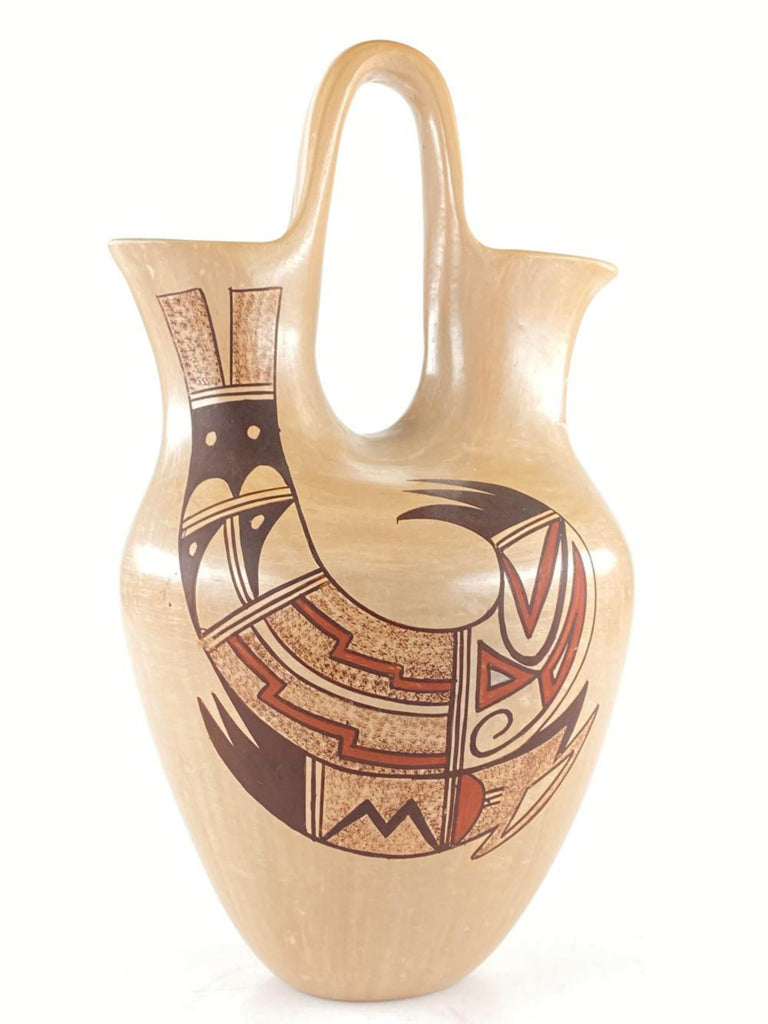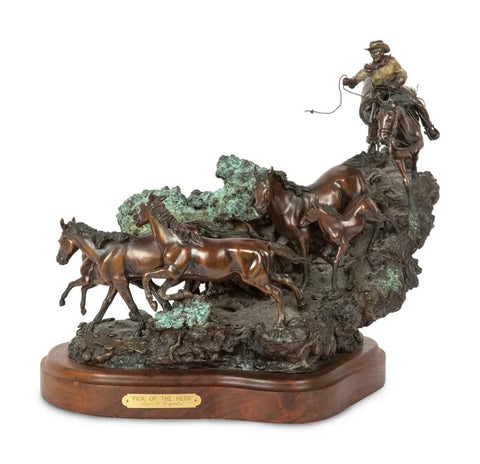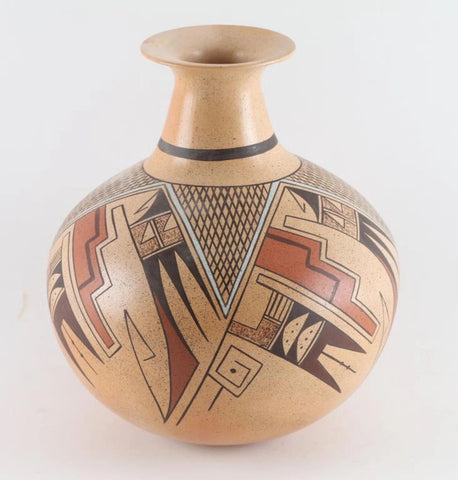
Native American Vintage Hopi Tewa Wedding Vase with Rainbirds, by Dawn Navasie, Ca 1990's, #1548 Sold
$ 1,312.00
Native American Vintage Hopi Tewa Wedding Vase with Rainbirds, by Dawn Navasie, Ca 1990's, #1548
Description: #1548 Native American Vintage Hopi Tewa Wedding Vase with Rainbirds, by Dawn Navasie, Ca 1990's. This Vintage Hopi Tewa Wedding Vase by Dawn Navasie is perfect southwest decor and a thoughtful presentation to any newlywed! The clay was hand built in coils and pinched smooth and shaped by hand. It was free-hand painted with rain-birds in bee-weed and red clay slip and then sheep dung fired. A stone polishing adds a soft sheen to the background. and is signed. A wonderful addition to any pueblo collection, this Vintage Hopi Tewa Wedding Vase is one of a kind!
Dimensions: It's about 6-1/4" wide and 10"tall
Condition Report: This piece is in great condition, with wear commensurate with age.
Provenance: Dawn (1961- ) was born into the Water Clan at Second Mesa. She was taught by her mother Eunice (Fawn) and has been active since 1978. She paints with a sure hand and has a design vision that recalls the beauty and quality. Dawn Navasie, Hopi Pueblo is a daughter of Eunice Navasie (Fawn). Her siblings are Dolly Joe Navasie (White Swann), Fawn Garcia Navasie (Little Fawn or Fawn) and several brothers. Both her sisters are potters. Little Fawn assumed the title Fawn following her mother’s death. Dawn is a niece of Justin and Pauline Setalla and Perry and Joy Navasie (Frogwoman). The whole clan is known for excellent pottery production. (Source: Adobe Gallery).
Some background on Pueblo pottery making follows:
“Pueblo pottery is made using a coiled technique that came into northern Arizona and New Mexico from the south, some 1500 years ago. In the four-corners region of the US, nineteen pueblos and villages have historically produced pottery. Although each of these pueblos use similar traditional methods of coiling, shaping, finishing and firing, the pottery from each is distinctive.
Various clay's gathered from each pueblo’s local sources produce pottery colors that range from buff to earthy yellows, oranges, and reds, as well as black. Fired pots are sometimes left plain and other times decorated—most frequently with paint and occasionally with applique. Painted designs vary from pueblo to pueblo, yet share an ancient iconography based on abstract representations of clouds, rain, feathers, birds, plants, animals and other natural world features.
Tempering materials and paints, also from natural sources, contribute further to the distinctiveness of each pueblo’s pottery. Some paints are derived from plants, others from minerals. Before firing, potters in some pueblos apply a light colored slip to their pottery, which creates a bright background for painted designs or simply a lighter color plain ware vessel. Designs are painted on before firing, traditionally with a brush fashioned from yucca fiber.
Different combinations of paint color, clay color, and slips are characteristic of different pueblos. Among them are black on cream, black on buff, black on red, dark brown and dark red on white (as found in Zuni pottery), matte red on red, and poly-chrome—a number of natural colors on one vessel (most typically associated with Hopi). Pueblo potters also produce un-decorated polished black ware, black on black ware, and carved red and carved black wares.
Making pueblo pottery is a time-consuming effort that includes gathering and preparing the clay, building and shaping the coiled pot, gathering plants to make the colored dyes, constructing yucca brushes, and, often, making a clay slip. While some Pueblo artists fire in kilns, most still fire in the traditional way in an outside fire pit, covering their vessels with large potsherds and dried sheep dung. Pottery is left to bake for many hours, producing a high-fired result.
Today, Pueblo potters continue to honor this centuries-old tradition of hand-coiled pottery production, yet value the need for contemporary artistic expression as well. They continue to improve their style, methods and designs, often combining traditional and contemporary techniques to create striking new works of art.” (Source: Museum of Northern Arizona)









